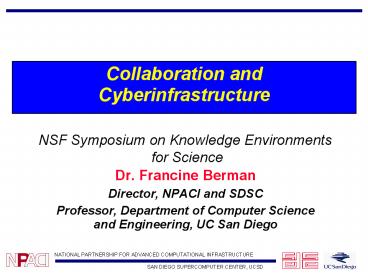Collaboration and Cyberinfrastructure - PowerPoint PPT Presentation
1 / 19
Title: Collaboration and Cyberinfrastructure
1
Collaboration and Cyberinfrastructure
NSF Symposium on Knowledge Environments for
Science
- Dr. Francine Berman
- Director, NPACI and SDSC
- Professor, Department of Computer Science and
Engineering, UC San Diego
2
Outline of Presentation
- How we collaborate today
- Collaboration and cyberinfrastructure -- More
than technical challenges - Changing the rules to promote collaboration in
cyberinfrastructure
3
How we collaborate today
4
Collaboration enables science
- Science as a team sport
- Grand Challenge Projects
- Formal program for multi-disciplinary
collaborations to attack largest-scale problems - Community Databases
- Broad collaboration to build key resources for
science
NationalVirtualObservatory
5
Collaboration creates new science
- SETI_at_home
- 3.8M users in 226 countries
- 1200 CPU years/day
- 38 TF sustained (Japanese Earth Simulator is 40
TF peak) - 1.7 ZETAFLOP over the last 3 years (1021,
beyond peta and exa )
6
Collaboration increasingly prevalent for
non-scientists
- Sharing as a default mode of interaction
- The Internet
- Globalization
- Open source
- Napster
- Distributed Entertainment Everquest
- 45 distributed clusters supporting 430,000
players - Real-time interaction and collaboration,
individualized database management, back channel
communication between players - Game masters collaborate with players for
real-time game management
7
Collaboration is fundamental for the next
generation of science advances
Cyberinfrastructure
BIRN
NSF PACI
Grid Computing provides a framework for
collaboration which both enables science and
creates new science
8
Collaboration andCyberinfrastructure
9
More than technical challenges
- Collaboration is a fundamental paradigm for
cyberinfrastructure - Technical support for collaboration in
cyberinfrastructure is not enough - Cyberinfrastructure program must be structured
to promote and incentivize collaboration
Collaboration is central to cyberinfrastructure
10
Over the last two decades, NSF has played a
leading role in Information Infrastructure
- Supercomputer Centers program brought high-end
computation to the open scientific community - PACI partnerships focusing on collaboration and
critical infrastructure development driven by
science needs - Perhaps the largest worked example of
collaboration to date - Cyberinfrastructure must be designed to meet the
hardware, software, and human infrastructure
needs of the next generation of science and
technology - Will need to take collaboration and partnership
to new levels
11
Cyberinfrastructure will bring new challenges
Supercomputing
Cyber-computing
Aggregate power,storage, bandwidthEnd-to-end
performance, ease of use Principal foci HW,SW
Power (FLOPS), size of run, length Principal
Focus HW
Conventional measures of evaluation
Coordinating SW, interfaces, distributed use and
access
OS, compilers, Schedulers for supercomputers
Focus of SW development
In addition, data-oriented users, Grid users,
users of remote instruments, DBs
Largely compute- intensive users
User base
12
Cyberinfrastructure will bring new challenges
13
New rules will be needed to ensure the success of
cyberinfrastructure
- Program which promoted success for supercomputer
centers will not incentivize for success for
cyber-centers - Notion of partnership going forward must be more
coordinated than original PACI program - Cyberinfrastructure requires long-term commitment
- Cyberinfrastructure program must incentivize for
real cooperation - Program must incentivize for serious SW
infrastructure development - Persistent, stable infrastructure, not just
demos - Program must have large-scale resources
- Compute, data, networks, viz
- Grid computing is not a replacement for
investment in high-end resources. - Program must recognize the importance of human
infrastructure - Scope/goals/budget should account for human
infrastructure needed for success
14
New metrics will be needed to ensure the success
of cyberinfrastructure
- What will it mean for cyberinfrastructure to be
successful? - What metrics will promote long-term success?
- What metrics will incentivize cooperation?
- What will it mean for software to be usable?
- How will we know if were serving the needs of
the disciplinary communities? - New metrics will be needed to ensure that
cyberinfrastructure is successful
15
Changing the rules to promote collaboration in
cyberinfrastructure
16
Hierarchy and Collaboration
- The U.S. Transportation Model
- Hubs provide full-service, large-scale facilities
- More than one hub amortizes traffic and provides
geographical distribution - New hubs not added without considerable thought,
planning, experience - Regional airports provide end-to-end service
through hubs
- All sites must collaborate to ensure success for
travelers
17
Food for thought -- A Collaborative Model of
Cyberinfrastructure
- Tier 1 sites provide leadership, full
functionality - Sites have unique large-scale facilities, large
expert staff - Tier 1 sites natural venue for SW development,
last help desk, etc. - Sites must cooperate for best success
- End-to-end performance will be dependent on
coordination - Model must support evolution and growth
- New sites will require new funding
- New Tier 1 sites should start as Tier 2 sites to
demonstrate readiness - Model must promote persistence and stability
- Stringent review, long-term planningrather than
re-competitions and incremental short-term plans
- Tier 1 sites provide high-end facilities, SW, HW,
infrastructure, and science leadership - Tier 2 sites provide value added (e.g. data
center, ocean center), coordinate with Tier 1
sites for end-to-end solutions
18
Cyberinfrastructure is an NSF-wide activity
- Collaboration among NSF Directorates is critical
- Needs of disciplinary communities should drive
research, development and procurement agendas - Building a successful cyberinfrastructure will
require an unprecedented level of community
collaboration, including - Researchers (to address cyberinfrastructure-specif
ic disciplinary and computer science problems) - Technologists (to provide stable, evolutionary
infrastructure, not demos) - Funding agencies (to develop programs which
promote collaboration and coordination, to
provide long-term agency advocacy) - Developing stable, usable cyberinfrastructure is
hard we will need to build on current successes
to retain leadership - Dont reinvent the wheel -- Communities should
leverage core infrastructure, allowing new
efforts to focus on new functionalities
19
Thank You
- berman_at_sdsc.eduSan Diego Supercomputer Center
- National Partnership for Advanced Computational
Infrastructure - www.sdsc.edu, www.npaci.edu































